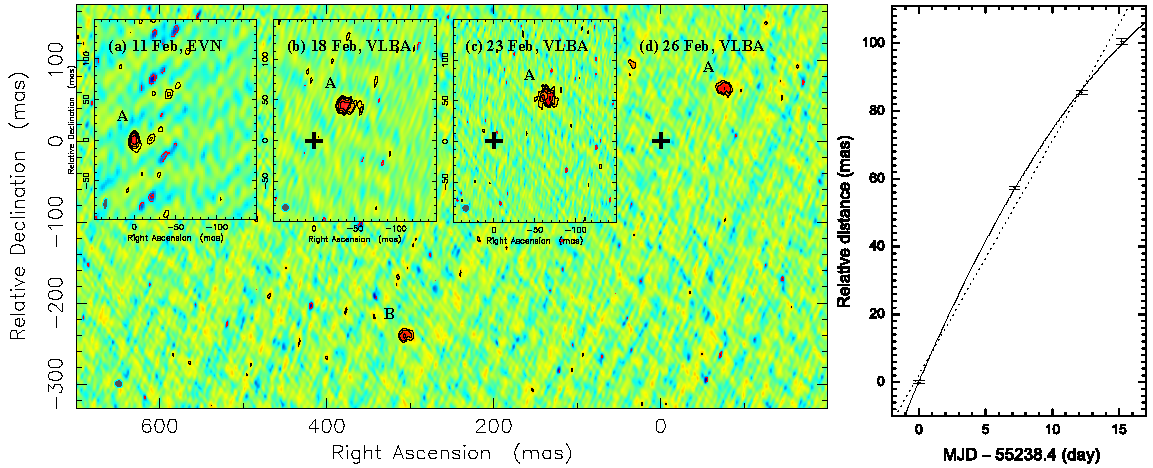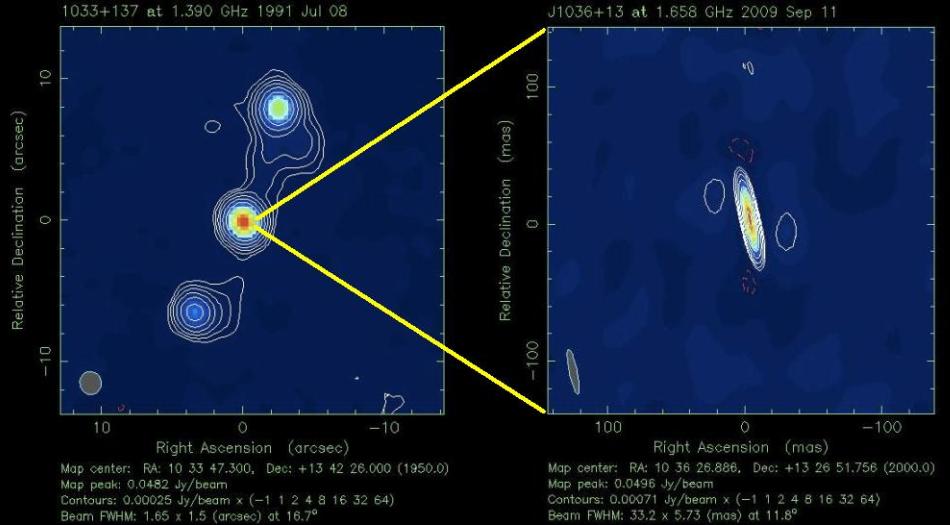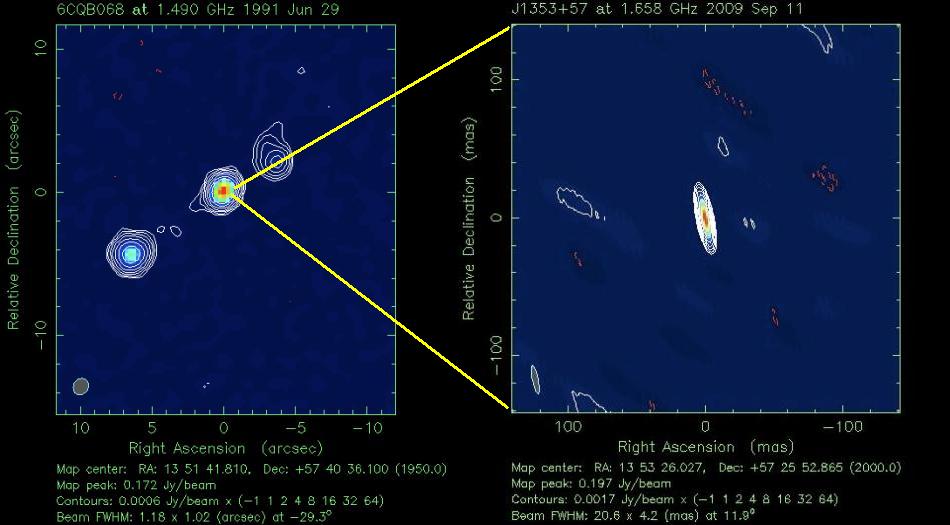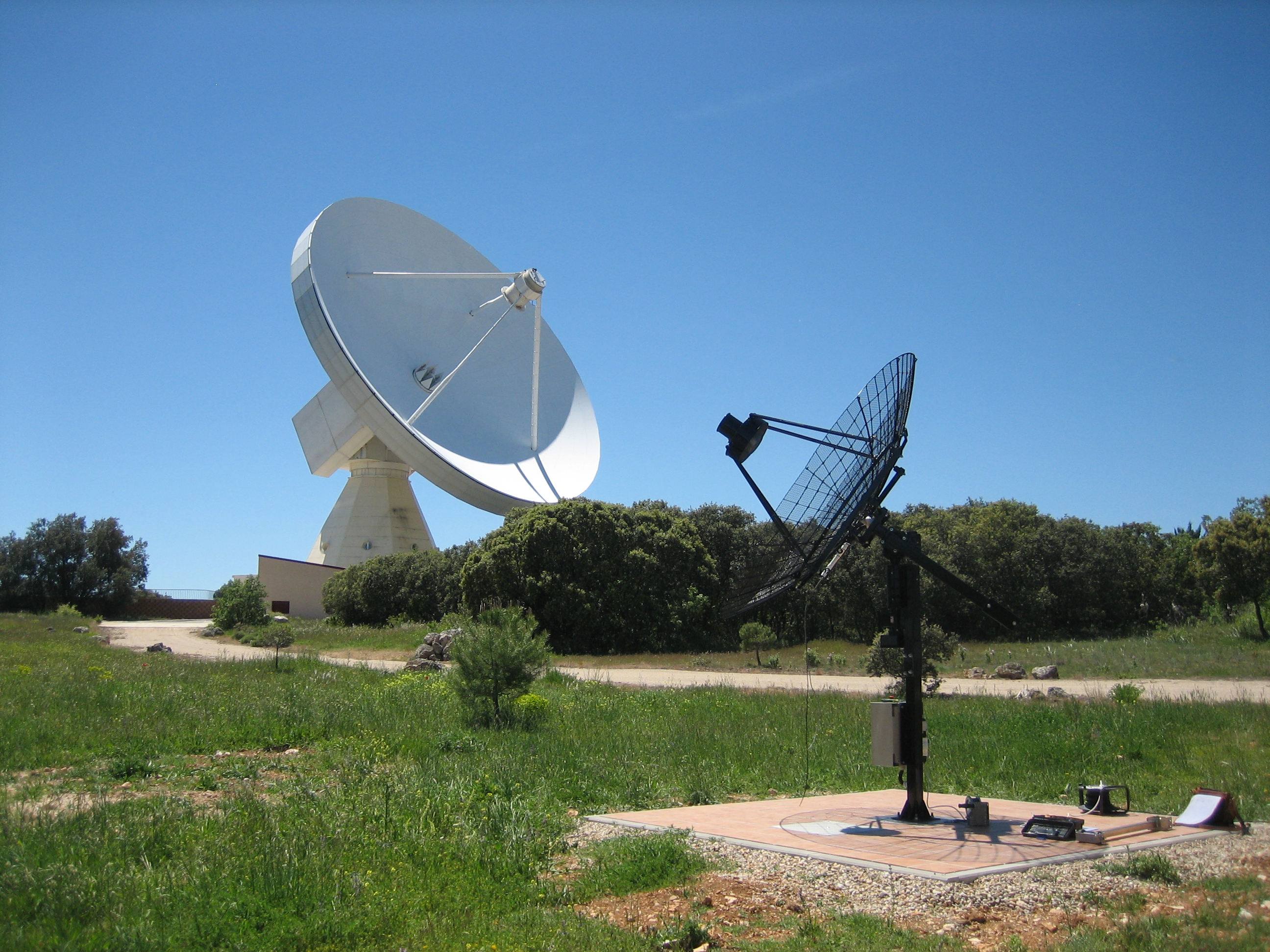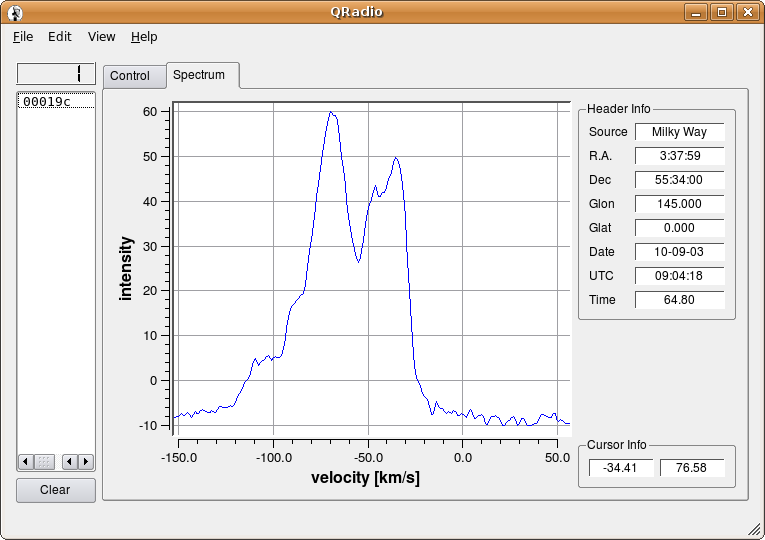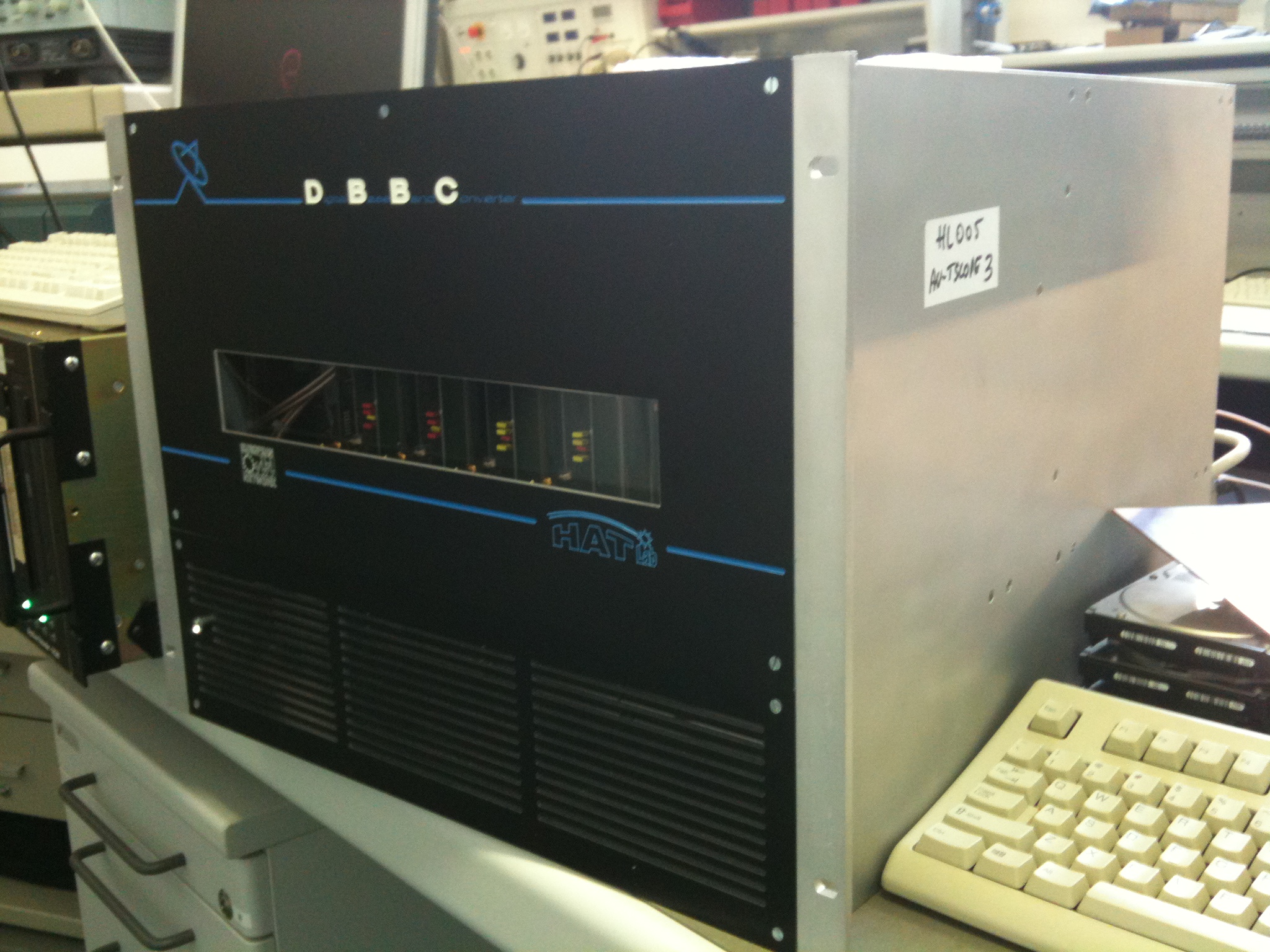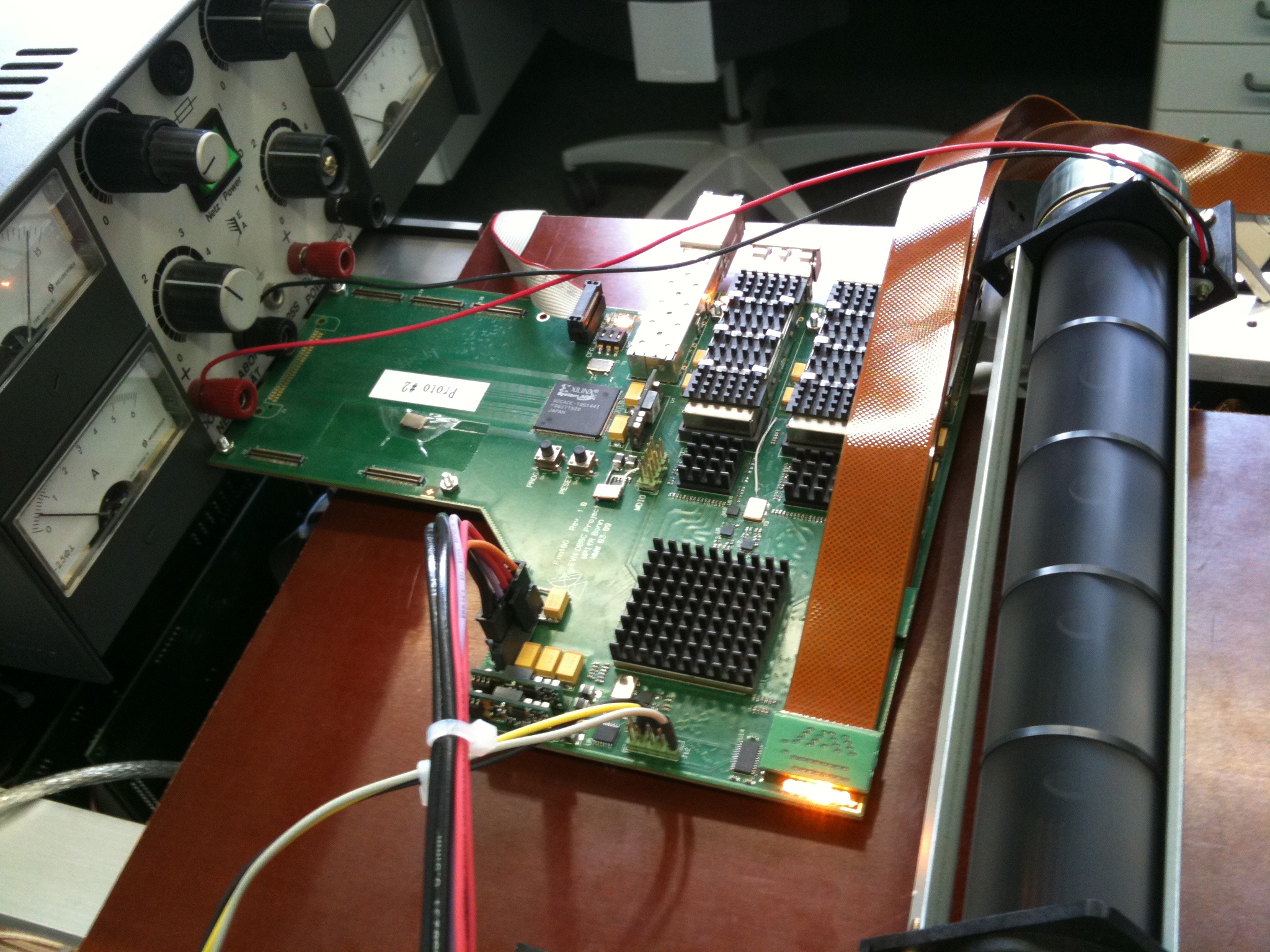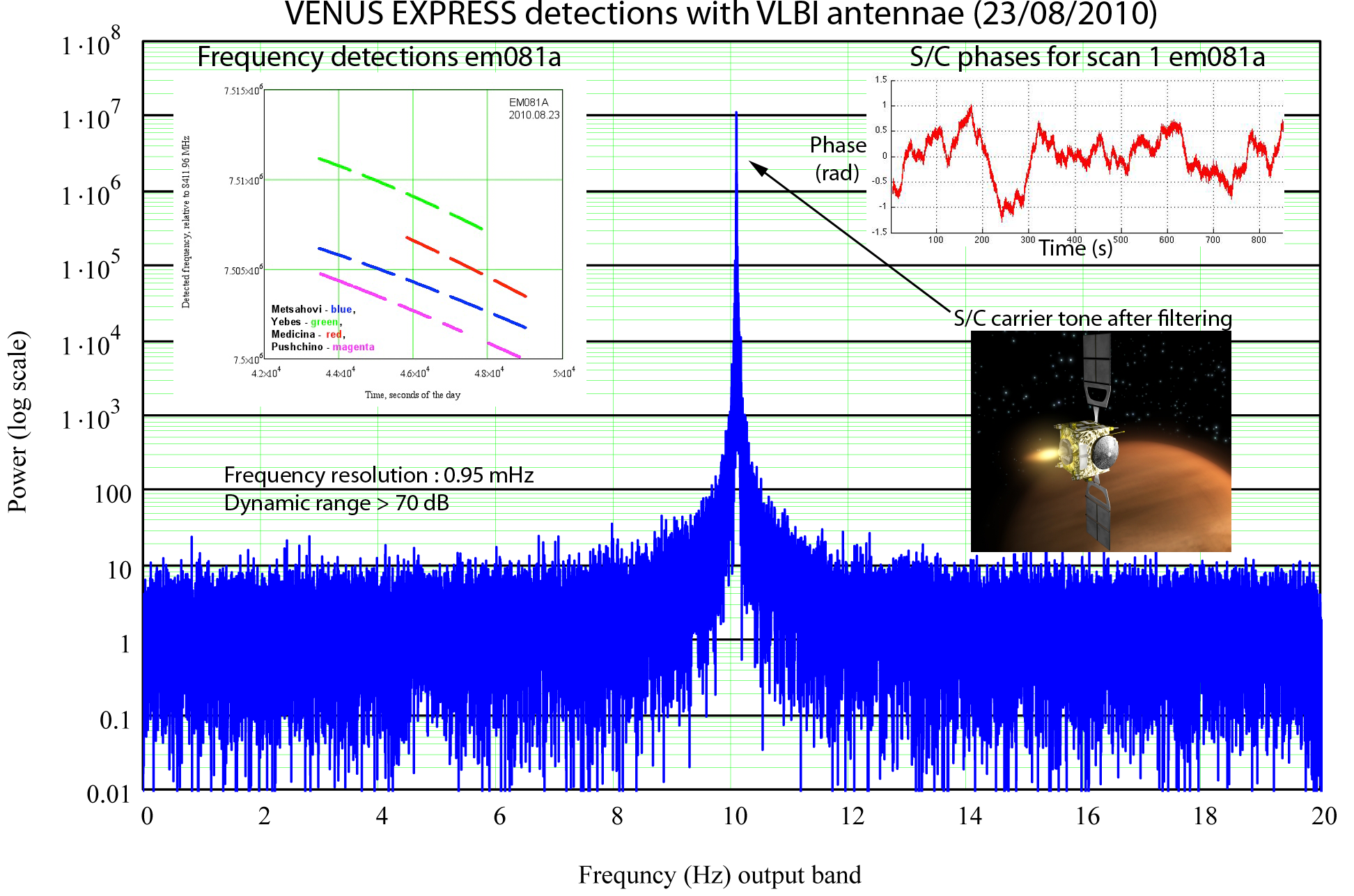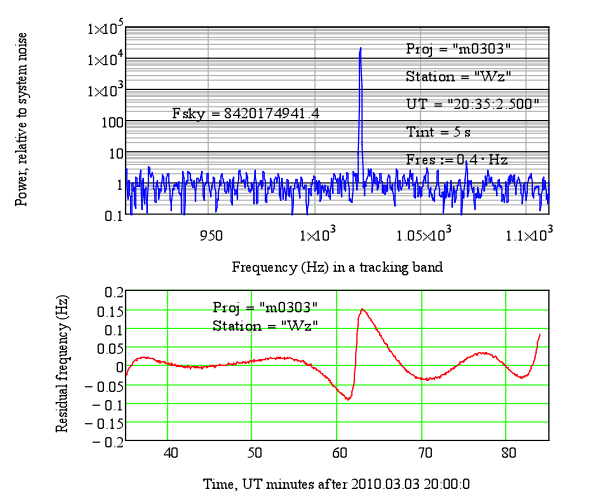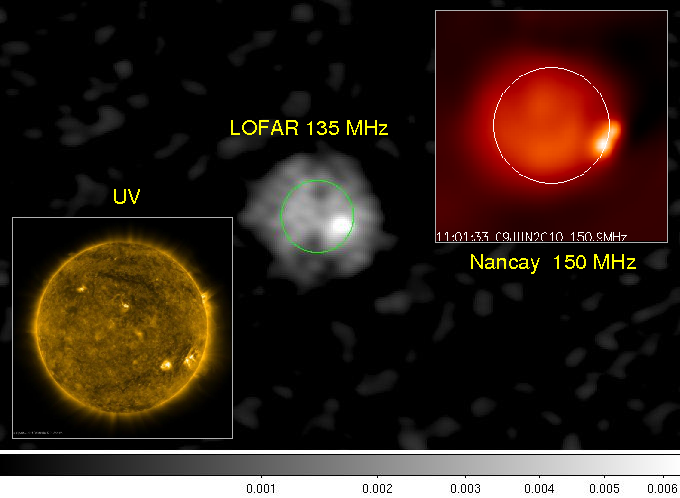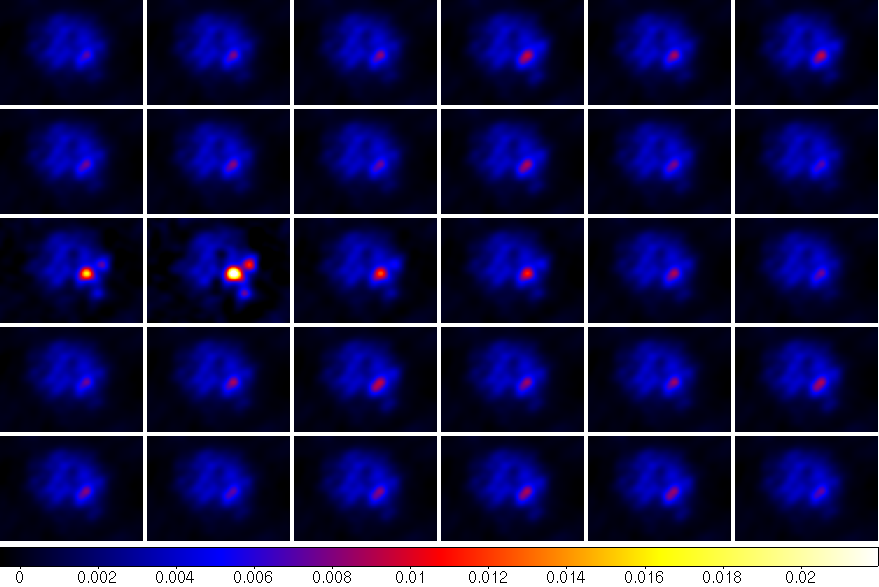|
|
European
VLBI Network Newsletter Number
27 September 2010 |
|
Contents
|
|
1.
Message from the
EVN Chairman 2.
Call for EVN
Proposals - Deadline October 1st 2010 4.
EVN technical
development and operations: |
|
|
1. Message
from the EVN Chairman
First of all I would like to thank all, who contributed to the September
issue of the
Newsletter, but special thanks go to the editor Magdalena Kunert-Bajraszewska
for her work and
patience when dealing with always busy authors.
In the issue we can read as usually about several interesting and important
for the EVN
developments, both in the science area and the technical improvements.
Scientific highlights reported in the newsletter contain only a small
portion of that, what is
currently being much better and broader reviewed at the EVN Symposium in
Manchester . It has been
rather difficult to collect more information on recent research activities
as the most of European
VLBI-ers were working hard to prepare their contributions to the Symposium .
Thus we are double
grateful to those who helped to make this newsletter interesting.
On the technical developments and improvements two events are of great
importance.
Some of us already know that the Hartebeesthoek 26m radio telescope has been
put back into operation
after long brake caused by damage of polar shaft bearing. The failure
occurred in October 2008,
the decisions to repair the telescope were taken a year ago, and the final
work started in March
2010. As an effect of intensive activity, the telescope restarted its
operation on July 20th with
the first VLBI observations conducted two days later. On August 26th the
first scheduled e-EVN day
after the summer, JIVE was very pleased to announce that good fringes were
obtained with Hart in a
1024 Mbps observing mode. Inclusion of Hartebeesthoek in 1024 Mbps
observations significantly
improves the performance of the e-EVN for low-declination sources.
I'd like to express my congratulations and thanks to Professor Roy Booth and
his team. The 26m
telescope is the only of this kind in Africa, particularly important
element of global and European
VLBI networks. Special thanks go also to Michael Gaylard the Acting
Managing Director and Jonathan
Quick - Friend of VLBI. A separate congratulations and thanks to JIVE
Director and the JIVE staff
for the arranging the session, and for the successful real time correlation
with express
distribution of results.
The second important news concerns the DBBC production. The HAT Lab
delivers first systems, please
read details in section under the topic on VLBI techniques.
EVN involvement in the Space Science described in two news shows its growing
potential and new
capabilities for future projects.
To finish the chairman's introduction I ask all the readers to continuously
encourage new students to
use the EVN for their astronomical research. After many years of
developments and improvements, the
EVN is becoming a straight forward, user friendly international facility,
significant part of the
advanced European Research Infrastructure. The EVN stretching E-W from
China to the US and N-S from
Sweden to South Africa, with large antennas and multi-country participation
creates the most
sensitive, highest angular resolution network. It will maintain the
leading position as the
powerful astronomical instrument on the Northern hemisphere for many decades
in the future.
Andrzej Kus, Chairman of the EVN Board of Directors.
2. Call
for EVN Proposals - Deadline October 1st 2010
ALL EVN,
GLOBAL, and e-VLBI PROPOSALS must now be submitted
with the
ONLINE
PROPOSAL SUBMISSION tool Northstar.
(This text is also
available on the web at http://www.ira.inaf.it/evn_doc/call.txt)
Observing proposals are
invited for the EVN, a VLBI network of radio telescopes spread throughout
The
observations may be conducted with disk recording (standard EVN) or in real-time
(e-VLBI).
The
EVN is open to all astronomers. Use of the Network by astronomers not
specialized in the VLBI technique is encouraged.
The
Joint Institute for VLBI in Europe (JIVE) can provide support and advice on
project preparation, scheduling, correlation and analysis. See EVN User Support
at http://www.jive.nl.
Future Standard
EVN Observing Sessions (disk recording)
|
2011 Session 1 |
Feb 24 - Mar 17 |
18/21cm, 6cm ... |
|
2011 Session 2 |
May 26 - Jun 16 |
18/21cm, 6cm ...
|
|
2011 Session 3 |
Oct 20 - Nov 10 |
18/21cm, 6cm ...
|
Proposals received by 1st October 2010 will be considered for scheduling
in Session 1, 2011 or later. Finalisation of the planned observing
wavelengths will depend on proposal pressure.
Future e-EVN
Observing Sessions (real-time correlation)
|
2010 Nov 23 - Nov 24 (start at 13
UTC) 2010 Dec 15 - Dec 16 (start at 13
UTC) 2011 Jan 25 - Jan 26 (start at 13
UTC)* 2011 Feb 15 - Feb 16 (start at 13
UTC)* |
18/21cm, 6cm, 5cm or 1.3cm 18/21cm, 6cm, 5cm or 1.3cm 18/21cm, 6cm, 5cm or 1.3cm
18/21cm, 6cm, 5cm or 1.3cm
|
*Dates for 2011 still provisional. Please consult the e-EVN web page
at
http://www.evlbi.org/evlbi/e-vlbi_status.html
to check for possible
updates, and for the available array.
e-VLBI proposals submitted by the October 1st deadline will be
considered for scheduling in the above sessions starting from November 2010.
Note
that only one wavelength will be run in each session, depending on proposal
priorities.
See http://www.ira.inaf.it/evn_doc/guidelines.html for details
concerning the e-VLBI observation classes and the observing modes.
Hartebeesthoek has been repaired and is again available for the
observations with the EVN.
Due to e-MERLIN commissioning, only a subset of the e-MERLIN array
is likely to be available in early 2011.
For updated information
please consult the web at http://www.e-merlin.ac.uk/vlbi
Please note that EVN + e-MERLIN projects will only be considered for
separate EVN and e-MERLIN observations when e-MERLIN has been fully
commissioned.
Please
consult
http://www.evlbi.org/evlbi/e-vlbi_status.html
and the EVN User Guide (
http://www.evlbi.org/user_guide/user_guide.html"
for updates on the current EVN and e-EVN array; availability of
different stations per observing band and for the dates of the e-EVN
observing sessions.
Large
EVN projects Most
proposals request 12-48 hrs observing time. The EVN Program Committee (PC) also
encourages larger projects (>48 hrs); these will be subject to more detailed
scrutiny, and the EVN PC may, in some cases, attach conditions on the release of
the data. All
EVN, Global and e-VLBI proposals (except ToO
proposals) must be submitted using the on-line proposal
submission tool Northstar. Global proposals will
be forwarded to NRAO automatically and do not need to be submitted to NRAO
separately.
New proposers should register at
http://proposal.jive.nlFeatures
for the next regular EVN and e-VLBI sessions
How to
submit
Additional
information
Further information on
Global VLBI, EVN+MERLIN and e-VLBI observations, and guidelines for proposal
submission are available at:
http://www.ira.inaf.it/evn_doc/guidelines.html
The
EVN User Guide (http://www.evlbi.org/user_guide/user_guide.html) describes
the network and provides general information on its
capabilities.
The
current antenna capabilities can be found in the status tables. For the standard
EVN see http://www.evlbi.org/user_guide/EVNstatus.txt. For the
e-VLBI array see http://www.evlbi.org/evlbi/e-vlbi_status.html
The
On-line VLBI catalogue (http://db.ira.inaf.it/evn/) lists
sources observed by the EVN and Global VLBI.
Tiziana Venturi - Chairperson of the EVN Program
Committee
3. EVN
Scientific Highlights
A decelerating jet observed by the EVN and VLBA in the X-ray transient XTE
J1752-223
The newly discovered Galactic X-ray transient XTE J1752-223 entered its
first known outburst in 2010, emitting from the X-ray to the radio regimes.
Its general X-ray properties were consistent with those of a black hole
candidate in various spectral states, when ejection of jet components is
expected. To verify this, we performed very long baseline interferometry
(VLBI) observations with the European VLBI Network (EVN) in e-VLBI mode and
the Very Long Baseline Array (VLBA) at four epochs in 2010 February.
The imaging results are displayed in Fig. 1. These images show that a moving
jet component, marked as "A", is decelerated at a rate of 0.34
milliarcsecond per square day by the last epoch, when a new jet component
("B") appears that is likely to be associated with the receding jet side.
The overall picture is consistent with an initially mildly relativistic jet,
interacting with the interstellar medium or with swept-up material along the
jet. The brightening of the receding component can be well interpreted by
initial Doppler deboosting of the emission in the decelerating jet. The
discovery provides strong evidence for the existence of interaction around
the jet at an early stage of its evolution.
Further details of this work can be found in Yang et al. 2010, MNRAS Letters
(accepted), arXiv:1009.1367 http://arxiv.org/abs/1009.1367
Authors:J. Yang (JIVE), C. Brocksopp (MSSL-UCL), S. Corbel (Univ.
Paris Diderot, CEA Saclay - AIM), Z. Paragi (JIVE), T. Tzioumis (ATNF), R.P.
Fender (Univ. Southampton)
|
Fig.1: The decelerating jet of the black hole candidate XTE J1752-223. All the colour images are centred at the location of component A on 2010 Feb. 11 (MJD 55238.4), indicated by a cross. The contours start from 3 sigma off-source noise level and increase by a factor of -1.4, -1, 1, 1.4, 2, 2.8. In the right panel, we fitted the proper motion data of component A to the models with (solid curve) and without deceleration rate (dotted line). It is clearly that the solid curve fits the data much better than the dotted line. |
Origin of the complex radio structure in BALQSO 1045+352
We present new more sensitive high-resolution radio observations of
a compact BAL quasar, 1045+352, made with the EVN+MERLIN at 5 GHz.
They allowed us to trace the connection between the arcsecond
structure and the radio core of the quasar. The radio morphology of
1045+352 is dominated by a knotty jet showing several bends (Fig.1).
We discuss possible scenarios explaining
such complex morphology: galaxy merger, accretion disc instability,
precession of the jet and jet-cloud interactions.
It is possible that we are whitnessing in this source an ongoing
jet precession due to internal instabilities within the jet flow,
however, a dense environment detected in the submillimeter band
and an outflowing material suggested by the X-ray absorption
can strongly interact with the jet. It is difficult to
establish the orientation between the jet axis and the observer in
1045+352 because of the complex structure. Nevertheless taking into
account the most recent inner radio structure we conclude the radio
jet is oriented close to the line of sight which can mean that the
opening angle of the accretion disc wind can be large in this source.
We also suggest that there is no direct correlation between
jet-observer orientation and a possibility of observing BALs.
1045+352 is a CSS object and a HiBAL quasar at a medium redshift. Its
linear size (~4 kpc) indcate it is a
young object in the early phase of quasar evolution.
The radio morphology of 1045+352 is dominated by the
strong radio jet resolved into many sub-components and changing the
orientation during propagation in the central regions of the host
galaxy. As a consequence we observe at least three phases of jet activity
indicate different directions of the jet outflow: components
A2-A3 as the oldest one, structure
A1-B as the younger one, and the jet A as the current activity
direction (Fig.1).
The above results have been published in
Kunert-Bajraszewska et al.(2009), ApJ, 705, 1356 and Kunert-Bajraszewska et
al.(2010), ApJ, 718, 1345
Authors:
M. Kunert-Bajraszewska (TCfA), M. Gawronski (TCfA), A. Janiuk (CAMK),
A.Siemiginowska (SAO)
|
Fig.1: Radio images of 1045+352 at 5 GHz made with (from left): MERLIN, EVN+MERLIN, EVN. Contours increase by a factor 2 and the first contour level corresponds to ~3 sigma. Indications: C - radio core, A-A3 - radio jet, B - probable counter-jet. |
Two core-dominated triple sources at z>3
The most spectacular examples of recurrent activity in radio-loud AGNs are
the rare
double-double or triple-double radio galaxies. In these objects, the inner
and outer
pairs of lobes have a common centre and are generally well aligned (within
~8 degrees).
The only double-double radio quasar candidate to date is 4C02.27. The two
highest
redshift objects known with confirmed episodic activity are 3C294 (z=1.877)
and
J1835+6204 (z=0.51).
We selected two radio quasars (J1036+1326 and J1353+5725) based on their
1.4-GHz
radio structure, which is dominated by a bright central core and a pair of
weaker and
nearly symmetric lobes at ~10" angular separation (i.e. core-dominated
triples, CDTs).
They are optically identified in the Sloan Digital Sky Survey (SDSS) at
spectroscopic
redshifts z>3. We investigated the possibility that their CDT morphology can
be a sign
of restarted radio activity, involving a significant repositioning of the
radio jet axis.
To check whether the VLA cores of J1036+1326 and J1353+5725 are resolved
(for example,
show a small separation double structure, thus indicating a restarting AGN
activity) or
unresolved (thus showing evidence of a compact jet) on 10 milli-arcsecond
scales, we
carried out EVN observations at 1.6 GHz. The 6-hour observations were
accommodated in
the 2009 September 10-11 e-VLBI run. To investigate if the large-scale
morphology is
dominated by beamed or unbeamed emission, we estimated the arm-length ratio.
We assumed
that the observed ratios are the result of relativistic motions over the
lifetime of the
sources rather than the difference in the environment on the two sides. In
particular,
from the arm-length ratio alone, we can infer that there is mildly
relativistic motion
in the case of J1353+5725.
As a starting hypothesis, we assumed that the inner radio jets that remain
compact with
VLBI are well aligned with the ~100-kpc scale radio structure we see in the
VLA images.
Using the estimated range of the allowed viewing angles, we can calculate
the Doppler
boosting factors and compare the expected brightness temperatures with our
measured
values, in order to determine whether we need to introduce large
misalignments to describe
the observed morphology. In case of J1036+1326, even the possible maximum
value of the
estimated viewing angle can be made consistent if the Lorentz factor is ~11.
However,
models of the inner jet with much higher Lorentz factors, hence smaller
viewing angles,
should be considered because of the quasar identification of the source. If
we allow for
a very high Lorentz factor of ~30, the misalignment would be ~40 degrees. In
case of
J1353+5725, we can construct a set of reasonable physical and geometric
parameters which
does not require jet repositioning and is fully consistent with our
observations. On the
other hand, the largest possible misalignment could reach about 70 degrees.
Considering
the steep spectra of the lobes, if one places these sources at e.g. z=0.5,
then the
(observed) 1.4-GHz flux density of the brighter lobes in these objects would
far exceed
that of the flat-spectrum core. In summary, we found that it is not
necessary to invoke
large misalignment between the VLBI jet and the large-scale radio structure
to explain
the observed properties of these two sources.
The paper describing the results in more details is accepted for publication
in
Astronomy & Astrophysics. The preprint is available at
http://arxiv.org/abs/1008.5335
Authors:
D. Cseh (CEA SAp), S. Frey (FOMI SGO), Z. Paragi (JIVE), L.I. Gurvits
(JIVE), K.E. Gabanyi (FOMI SGO)
|
|
|
Fig.1: 1.4-GHz VLA and 1.6-GHz EVN images of J1036+1326 (z=3.10, top) and J1353+5725 (z=3.46, bottom). |
4. EVN
Technical Development and Operations
SPIDER enhances outreach at Yebes
The activities performed at the National Astronomical Observatory in Spain
will be soon enhanced by the installation of a new instrument at Yebes:
SPIDER ("Small Parabolic Instrument for Demonstration, Education, and
Research"). Built by the Swedish company Are Elektronik following the
principles of the SALSA instrument developed by Onsala Space Observatory,
SPIDER is a fully operational 2.3 meter radio telescope equipped with an
L-band (21cm - 1420MHz) receiver and a spectrograph (352 channel
correlator, 2.4MHz total bandwidth). The beam width is 7 degrees. A low
noise preamplifier is mounted in the antenna focus and a coax cable feeds
the signal to a cabinet which contains the receiver, power supplies and a
modem. In the antenna vertex a small dipole antenna is installed for
calibration purposes.
This radio telescope is ideal for observing hydrogen in our galaxy, the Milky
Way. The main aim is to map the spiral arms of the Galaxy. The Onsala
software Qradio is used for controlling the radio telescope. This software
communicates with "kstars".
The goal of SPIDER is to provide the opportunity to operate a real
radiotelescope to students and visitors, in the environment of the Yebes
observatory, where the big 40 meter dish is closeby but not accessible to
them. The instrument could be operated remotely via internet from the other
OAN centres in Madrid or University of Alcalá, even directly from the
schools. Many of the applications are still to be designed, in coordination
with other EVN observatories which are part of the network of Visitor
Centres (VC-Net) sponsored by the EC FP7 project "RadioNet".
Francisco Colomer, José Manuel Serna, Beatriz Vaquero (OAN, Spain)
|
Fig.1: SPIDER installed next to the Yebes 40m radiotelescope. |
Fig.2: Example of SPIDER data. |
Note: Contact details for the company Are Elektronik:
Rune Bystrom
Are Elektronik; Ann Nissevagen 4. S-830 15 Â DUVED, Sweden
Ph: +46 647 50758; Fax: +46 70 6703293; Email: are.elektronik@telia.com
NEXPReS Funded and Launched
As anticipated, the EC approved 3.5M EUR funding for the NEXPReS
project (Novel EXplorations Pushing Robust e-VLBI Services), and work
began 1 July to build on progress made during EXPReS.
NEXPReS aims to incorporate e-VLBI into every astronomical observation
conducted by the EVN by marrying "the best of both worlds" - data
archiving and reprocessing afforded by traditional disk-based VLBI with
the speed and flexibility of e-VLBI.
All activities are beginning work, and the first Board meeting is
scheduled for September in Manchester, prior to the EVN Symposium.
Additional information about the project is available at
http://www.nexpres.eu/.
Kristine Yun (JIVE)
HAT-LAB delivers the first DBBC systems
The first batch of the DBBC back-end production has been
completed at the beginning of this September from HAT-Lab.
This company is a spin-off of the Italian INAF (Istituto
Nazionale di Astrofisica) established to produce the
DBBC backend and its components in collaboration with
IRA (Istituto di Radioastronomia) and MPI (Max Planck
Institute fuer Radioastronomie). The construction of
the systems has been realized in Noto, Catania and Bonn.
The first batch was composed by seven units to be
delivered to: Onsala (Sweden), SRT (Italy), Pico Veleta (Spain),
APEX (Chile), Auscope (two systems, Australia),
Auckland (New Zealand). These together with the already
deployed systems at: Noto (Italy), Effelsberg (Germany),
Yebes (Spain), Wettzell (three systems, Germany),
Auscope (Tasmania), provides a number of fourteen systems
on the field.
Other four units are at present under construction
in the HAT-Lab laboratories.
Delivery time for the first batch from HAT-Lab has been
around one year, longer than expected, and due to the
initial operations to be set with the sub-contractor
companies that had in charge the realization of the
boards composing the system. Full assembly and
testing has been done by HAT-Lab, IRA and MPI.
Delivery time for new orders is now expected around
four months.
HAT-Lab is going to produce now also the FILA10G board,
a 10Gbps Ethernet network card to be used to join the
MK5C recorder or any standard 10G network. It is also
available the optical-copper interface GLAPPER, to
link the glass connection media coming from the FILA10G
with the copper CX4 interface present on the MK5C or any
other device using such type of interface.
G. Tuccari - IRA (INAF)
|
Fig.1: DBBC VLBI Backend System |
Fig.2: FILA10G network interface to MK5C |
EVN Space Science Applications extend across Europe, the Earth and the Solar
system
The summer of 2010 was successful for EVN Space Science Applications in
practical observational work, data analysis and interpretation. We are happy
to welcome new observers from the Onsala (Sweden) and Warkworth (New
Zealand) observatories who have joined the group of Metsähovi (Finland),
Medicina, Noto, Matera (Italy), Wettzell (Germany), Yebes (Spain) and
Pushchino (Russia). The ESA Venus Express (VEX) spacecraft was observed in a
single dish mode with Onsala 20-m dish on 2010 August 30, and showed a
robust detection. About the same time, the brand new Warkworth antenna,
observed the ESA Mars Express (MEX) spacecraft. This 12-m Cassegrain
located in a picturesque Hobbit-like neighbourhood of Auckland on the other
side of Earth (see the great picture of it), is operated by the Institute
for Radio Astronomy and Space Research of Auckland University of Technology.
|
Photo: Alex Wallace |
Onsala observed VEX with a standard MkIV/Mk5/PCEVN data acquisition system.
The Warkworth antenna observed MEX with their home-made single channel BBC
with a bandwidth of 32 MHz, an 8-bit sampler and a PCEVN data capturer. The
recorded data were electronically transferred from both stations to
Metsähovi for processing and then to JIVE for analysis. Plots below show the
detected spectra for both Onsala and Warkworth on VEX and MEX, respectively.
|
|
|
Earlier in September a team of Warkworth and Metsähovi scientists, when
observing the MEX spacecraft, tested a direct eVLBI streaming of data from
New Zealand to Finland at data rate of 512 Mbps, over probably the longest
fibre path in the World. The data were streamed from the Warkworth PCEVN
data capture unit directly to a Linux RAID at Metsähovi using the tsunami
protocol. First tests were successful and we hope a good science can be done
soon with such observations, although more test are needed.
PhD students G. Molera Calves (Aalto University, Helsinki, Finland) and D.
Duev (Moscow State University, Moscow, Russia) and MSc student T. Bocanegra
Bahamon (Delft University of Technology, Delft, The Netherlands), all
working at JIVE during this summer, made significant contribution for the
observations and analysis of the spacecraft tracking data. The results of
the busy observing and data processing summer pave the way for future EVN
observations in the framework of the Planetary Radio Interferometry and
Doppler Experiment (PRIDE) - a multidisciplinary component of science
programmes of several prospective deep space missions.
Sergei Pogrebenko - JIVE
Observations of Mars Express and Venus Express spacecraft and first EVN VLBI
Space Science session.
The ESA Mars Express (MEX) and Venus Express (VEX) spacecraft have been
observed for the last two years with the European VLBI radio telescopes of
Metsähovi (Finland), Wettzell (Germany), Yebes (Spain), Medicina (Italy),
Matera (Italy), Noto (Italy), Puschino (Russia) and the latest ones Onsala
(Sweden) and Warkworth (New Zealand). The campaign is in a framework of the
assessment study of the possible contribution of the European VLBI Network
to the upcoming ESA deep space missions and it also brings new opportunities
for the radio astronomy science. Observations are carried out either in
single- or multi-dish mode when spacecraft is locked to the ESTRACK ground
station (Cebreros or New Nortia) observing the two-way link (up- and
down-link channel).
|
Fig.1: VEX Spacecraft detection on 23 August 2010, session EM081a. Subplot on the left corner shows the frequency detections for all the antennas and at the right is the extracted phase for the first S/C scan from Yebes. |
On 23th of August 2010 there was the first VLBI Venus Express tracking
session EM081A supported by the EVN program committee. VEX and the sources
J2156-0547 were alternatively observed along the six hours session. The
radio telescopes participants were Metsähovi, Medicina, Onsala, Yebes and
Puschino. Data was locally recorded in the stations using common VLBI
equipment and transferred almost immediately after the session using
tsunami-UDP software to Metsähovi Radio Observatory and to JIVE for the
processing, pre and post-analysis and the correlation. The high dynamic
range of the detections allowed us to determine the apparent topocentric
frequency of the S/C carrier line and down to milli-Hz spectral accuracy and
to extract the phase of the spacecraft signal carrier line. With such
multi-station observations the respective phases can be calibrated
per-baseline basis using VLBI phase referencing technique and observations
of near-by quasars using the far-field VLBI delay model for quasars and
near-field model for spacecraft.
The post-analysis of the spacecraft tracking data enables us to study
several parameters of the spacecraft signals, among which the phase
fluctuations of the signal can be used for characterization of the
interplanetary plasma (IP) density fluctuations along the signal propagation
line at different spatial and temporal scales and different Solar
elongations. These fluctuations are well represented by a near-Kolmogorov
spectrum.
|
Fig.2: Observational results of the MEX detections with Wettzell radio telescope on March 03 2010, during the Phobos fly-by. |
We also demonstrated such a high accuracy of Doppler tracking with 3 EVN
stations (Metsähovi, Wettzell and Yebes) during the MEX-Phobos flyby
occurred last 03th of March 2010. These multi-station observations sessions
could help to better determine the Phobos gravity field and together with
phase referencing can provide additional geometrical constrains on the
orbiter/Phobos trajectories. PRIDE-EVN observations of the Phobos-Grunt
Lander, which launch is planned to 2011 are also foreseen.
Guifré Molera Calvés, Aalto University Metsähovi Radio Observatory,
on behalf of PRIDE team.
5.
VLBI related news
First resolved images of the Sun with LOFAR
LOFAR, Europe's first and only dedicated low-frequency e-VLBI array, has
recently imaged the Sun for the first time. The observations were
initiated by the Solar Physics group at the AIP (Astrophysikalisches
Institut Potsdam) led by Prof. Gottfried Mann. Also involved in the
preparations were Frank Breitling and Christian Vocks (AIP), James
Anderson (MPIfR, Bonn), Antonis Polatidis (ASTRON, Dwingeloo) and Olaf
Wucknitz (AIfA, Bonn).
Eight ten-minute scans were taken on 9th June 2010 between 9:48 and 15:50
UT, four in the low band (LBA) and four in the high band (HBA). This date
was chosen to have a couple of bright calibrator sources in the field to
allow a proper phase calibration. The preliminary results shown here,
however, are based on self-calibration. This was made possible by the help
of a compact active region on the Sun acting as a compact phase-calibrator
source. The calibration and imaging was done by Olaf Wucknitz using a
combination of own software and difmap.
Additional material including movies of the time-variability can be found
here:
http://www.astro.uni-bonn.de/~wucknitz/publications/pub.php?2010_bochum_glow
Olaf Wucknitz (AIfA Bonn)
on behalf of the Solar KSP. LOFAR is a project of ASTRON (Dwingeloo).
|
Fig.1: One of the first resolved LOFAR HBA images of the Sun in a narrow frequency band near 135 MHz (centre) compared to a 150 MHz image from the Nancay Radioheliograph (right) and a UV images (left) taken at approximately the same time. Only short baselines were included in the LOFAR images to avoid the sparse uv coverage further outwards. We see that (a) the Sun appears larger at these frequencies than in the optical (green circle) and that (b) there is a compact active region that can also be seen in the comparison images. The resolution is a couple of arcmin, quite unusual for the EVN newsletter. |
Fig.2: The active region varies on timescales of seconds or below as seen in this sequence of 1 sec snapshots spanning an overall duration of 30 sec. Currently it is not clear whether the double structure of the brightest flare is real or an imaging artefact. A relatively narrow band was used for these images. Dynamic spectra show that the emission is highly variable not only as a function of time but also as a function of frequency. Details of this still have to be investigated. |
6.
Meeting Point
EVN Symposium, Manchester, 20th-24th September 2010
A few, very fresh photos from the EVN Symposium.
|
|
|
|
|
|
|
|
|
|
|
|
EVN Newsletter No. 27.
2010 European VLBI Network. Edited by Magdalena Kunert-Bajraszewska (TCfA, Poland).

